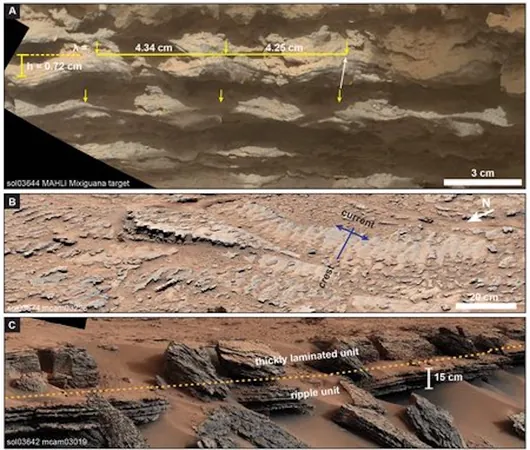
Unveiling Mars' Liquid Past: Curiosity Rover Discovers Ancient Wave Ripples!
2025-01-21
Author: Wei Ling
NASA's Groundbreaking Discovery
NASA’s Curiosity Rover, which has been on Martian ground since 2012, has made an astonishing discovery that could change our understanding of the Red Planet’s history. The rover has recently unearthed evidence of ice-free ancient ponds and lakes, revealing subtle, wave-like structures on the surface, reminiscent of sandy lake beds here on Earth. These small undulations, created by wind-driven water, suggest that Mars was once a much wetter place, potentially capable of supporting life nearly 3.7 billion years ago!
Mars' Environment Compared to Earth
It’s fascinating to note that Mars, the fourth planet from the Sun and the second smallest among the major planets, boasts a distinctive reddish hue due to iron oxide. Unlike Earth, where vibrant ecosystems thrive, Mars is a cold and dry world - with polar caps primarily composed of carbon dioxide ice and a thin, unbreathable atmosphere. The idea that it may have once been habitable has intrigued scientists for decades.
Curiosity Rover's Mission
Curiosity, which arrived at Mars in August 2012 after being launched in 2011, has been diligently studying the Gale Crater area. Equipped with state-of-the-art instruments—including drills for soil sampling and cameras for atmospheric analysis—the rover aims to probe Mars' climate and geology and assess its capacity for hosting primitive life in the past.
Ancient Wave Ripples Discovered
A recently published study in the journal *Science Advances* by researchers from Caltech, including the esteemed John Grotzinger, highlights two sets of ancient wave ripples that the rover has identified. These structures are critical indicators of past bodies of liquid water, preserved in Martian rock. Their findings revealed that the ripples, typically seen at the seashores and lakes of Earth, indicate that the water once flowed freely on the Martian surface, rather than being trapped under ice.
Implications of the Findings
The ripples observed by Curiosity could represent the strongest evidence yet of liquid water's existence on Mars. Through the analysis of their shapes and formations, researchers inferred that the climate must have been significantly warmer and denser than it is now—ideal conditions for liquid water.
Estimations of Ancient Lakes
Curiosity's team has crafted computer models based on the characteristics of these ripple formations to estimate the potential size of ancient lakes on Mars. The findings suggest the ripples' height of just 6mm and spacing of 4-5 cm imply that these were shallow bodies of water, possibly less than 2 meters deep. Among the discoveries were the Prow outcrop—a region once characterized by wind-blown dunes—and another set rich in sulcate markings known as the Amapari Marker Band. This duality indicates a complex climatic history, suggesting warmer atmospheres persisted at different periods in Martian history.
Conclusion and Future Exploration
This groundbreaking discovery significantly boosts our understanding of Mars' paleoclimate, offering a window into its changing conditions over billions of years. Notably, while NASA’s Opportunity rover initially found ripples in the Martian surface, the true nature and implications remained somewhat enigmatic until Curiosity's recent findings.
With this latest revelation, we are left to ponder: could Mars have once been dotted with lakes? What other secrets does this fascinating planet still hold? As investigations continue, the quest to uncover the history of liquid water on Mars is more unfolding than ever! Stay tuned for more exciting discoveries from Curiosity—who knows what other mysteries this robotic explorer will solve next!



 Brasil (PT)
Brasil (PT)
 Canada (EN)
Canada (EN)
 Chile (ES)
Chile (ES)
 Česko (CS)
Česko (CS)
 대한민국 (KO)
대한민국 (KO)
 España (ES)
España (ES)
 France (FR)
France (FR)
 Hong Kong (EN)
Hong Kong (EN)
 Italia (IT)
Italia (IT)
 日本 (JA)
日本 (JA)
 Magyarország (HU)
Magyarország (HU)
 Norge (NO)
Norge (NO)
 Polska (PL)
Polska (PL)
 Schweiz (DE)
Schweiz (DE)
 Singapore (EN)
Singapore (EN)
 Sverige (SV)
Sverige (SV)
 Suomi (FI)
Suomi (FI)
 Türkiye (TR)
Türkiye (TR)
 الإمارات العربية المتحدة (AR)
الإمارات العربية المتحدة (AR)